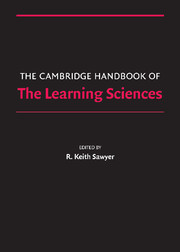Book contents
- Frontmatter
- Contents
- Preface
- Contributors
- 1 Introduction
- PART I FOUNDATIONS
- PART II METHODOLOGIES
- PART III THE NATURE OF KNOWLEDGE
- PART IV MAKING KNOWLEDGE VISIBLE
- PART V LEARNING TOGETHER
- 24 Computer-Supported Collaborative Learning
- 25 WILD for Learning
- 26 Arguing to Learn
- 27 Learning in Online Communities
- PART VI LEARNING ENVIRONMENTS
- Afterword: After How Comes What
- Epilogue: The Fundamental Issue in the Learning Sciences
- Author Index
- Subject Index
- References
25 - WILD for Learning
Interacting Through New Computing Devices Anytime, Anywhere
Published online by Cambridge University Press: 05 June 2012
- Frontmatter
- Contents
- Preface
- Contributors
- 1 Introduction
- PART I FOUNDATIONS
- PART II METHODOLOGIES
- PART III THE NATURE OF KNOWLEDGE
- PART IV MAKING KNOWLEDGE VISIBLE
- PART V LEARNING TOGETHER
- 24 Computer-Supported Collaborative Learning
- 25 WILD for Learning
- 26 Arguing to Learn
- 27 Learning in Online Communities
- PART VI LEARNING ENVIRONMENTS
- Afterword: After How Comes What
- Epilogue: The Fundamental Issue in the Learning Sciences
- Author Index
- Subject Index
- References
Summary
We use the acronym WILD to refer to Wireless Interactive Learning Devices. WILD are powerful and small hand-held networked computing devices. The smallest hand-held computers fit in one hand easily. The user interacts with the device either by touching the screen with a pen-shaped stylus, or by typing with both thumbs on a small keyboard known as a thumb-pad keyboard. The largest are the size of a paperback book and have a keyboard that is large enough to type on with all ten fingers. Their low price point and high usability have captured the imaginations of educators and learning scientists. The promise of harnessing computing where every student has his or her own computer, and where they are available everyday, anytime, anywhere – for equitable, personal, effective, and engaging learning – give WILD a greater transformative potential than desktop computers.
This chapter provides an account of the learning, education, social, policy, and technical contexts for these developments. We begin by establishing these contexts, and then survey available research on and commercial applications of WILD computing. We focus on efforts where the “technology in the WILD” is being used to bring learners into activities previously unreachable – whether because of administrative, time, financial, demographic, previous knowledge, accessibility, or academic constraints. We emphasize the unique features that WILD add to classroom dynamics and to learning in the world, both in formal and informal contexts. In closing, we review the technical convergences and societal trends in WILD computing that will shape this field.
Information
- Type
- Chapter
- Information
- The Cambridge Handbook of the Learning Sciences , pp. 427 - 442Publisher: Cambridge University PressPrint publication year: 2005
References
Accessibility standard: Unknown
Why this information is here
This section outlines the accessibility features of this content - including support for screen readers, full keyboard navigation and high-contrast display options. This may not be relevant for you.Accessibility Information
- 8
- Cited by
